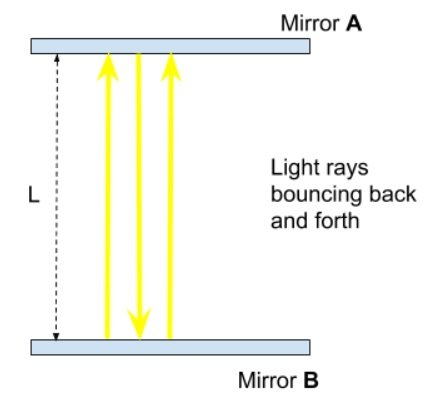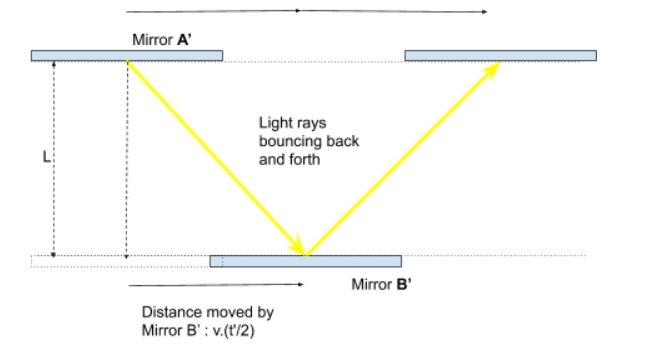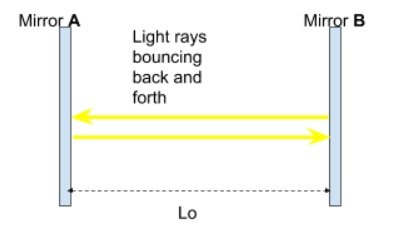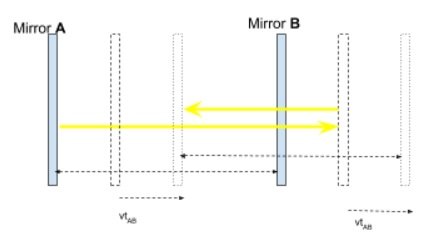Home » EasyPhys » The Nature of Light » Light and Special Relativity » Investigate the evidence, from Einstein’s thought experiments and subsequent experimental validation, for time dilation and length contraction
Investigate the evidence, from Einstein’s thought experiments and subsequent experimental validation, for time dilation and length contraction
Time Dilation
Einstein’s thought experiment consisted of clock made out of
- two mirrors A and B,
- and light bouncing back and forth within them.

- Let the distance between the two mirrors be L
- The speed of light is constant , denoted by c
- to is the time taken for light beam to go from Mirror A to Mirror B and reflect back to Mirror A again (one round trip)
The relation between the three variables is : ![]()
Now imagine a second clock
- composed of Mirror A’ and Mirror B’
- moving with velocity v , relative to the first clock .

- The time taken by light to move from Mirror A’ to B’ and back to A’ is t’
- time to move from A’ to B’ :

- Simplifying :

Thus we can see that time in the moving clock will appear dilated in comparison to the original clock.
The expression  is called the Lorentz factor
is called the Lorentz factor
Therefore ![]()
Length Contraction
The thought experiment for length contraction is slightly different.
Imagine again two mirrors A and B as shown below, with light bouncing in between them:

- distance between mirrors : Lo
- Time taken for light to go from Mirror A to mirror B = tAB
- Time taken for light to go from Mirror B to mirror A = tBA
- Total time : to = tAB + tBA
- Therefore

Now Imagine that this setup is moving to the right at the speed of v
- distance between mirrors : L
- Time taken for light to go from Mirror A to mirror B =

- Time taken for light to go from Mirror B to mirror A =

- Total time :


- In the time taken for the light ray to go from Mirror A to B , the whole setup has moved vt’AB distance forward.
- time taken =

- Therefore total length travelled =

- Hence,

- Now the light bounces back from Mirror B to Mirror A

- In the time taken for the light ray to go from Mirror B to A , the whole setup has moved vt’BA distance forward.
- time taken =

- Therefore total length travelled =

- Hence,

Putting these calculation together


– observations of cosmic-origin muons at the Earth’s surface
- In 1941 Rossi and Hall detected cosmic origin muons at the top of the mountain and at the ground level
- Muons are created by collision of high energy particles with atmosphere.
- The muons have a very short half life and were expected to reduce by significant number between the top of the mountain and the ground.
- Should only exist for 2 µs and not reach the surface.
- But Hall and Rossi observed that the numbers were significantly higher.
- This is because the muons were travelling at a very high speed and the time and distance measured on earth clock were not applicable to the muon.
- They were also observed existing for 16 µs at a point 10 km underground due to time/length dilation.
- After applying time dilation and length contraction, it was found that observed results matched expected results.
- Thus time and distance for the muon was different than observed from earth reference frame.
– atomic clocks (Hafele–Keating experiment)
- In 1941, Hafele and Keating carried extremely precise atomic clocks in a plane to compare the effects of time dilation with respect to atomic clocks on the ground .
- Three clocks were used, one on earth, one heading east and one heading west with a slightly higher speed (so the the two travelling clocks have the same speed relative to the earth based clock)
- Taking into account acceleration and gravity, it was found that the time dilation matched with Einstein’s prediction.
– evidence from particle accelerators
- In 2014 , physicists published work measuring rates of transition between energy states of atoms.
- The measurement were done between atoms in a particle accelerator travelling at one third speed of light and at rest in laboratory frame.
- The difference in rates matched with Einstein’s predicted time dilation.
– evidence from cosmological studies
- cosmological particles which travel at near light speeds travel for millions of years according to earth clocks but in its own reference frame has been found to have aged very little.
- Explosion of stars have also been observed to be taking much longer in our reference frame , and matches predictions instead made by time dilation.
Extract from Physics Stage 6 Syllabus © 2017 NSW Education Standards Authority (NESA)
